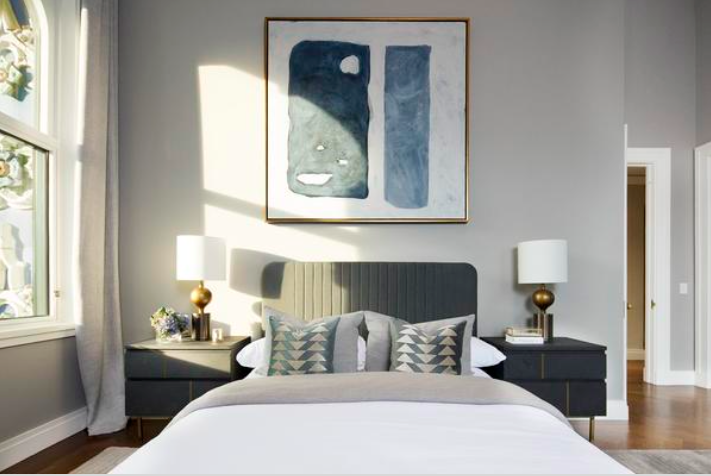Two hundred and eighty-eight hours. That’s real estate agent turned stager turned entrepreneur Cheryl Eisen’s timeframe for designing and installing multimillion-dollar properties of all sizes. That turnaround time is not so much a gimmick as it is a bottom-line pillar of Eisen’s thriving 11-year-old business, Interior Marketing Group (IMG), which is largely luxury home staging. As she puts it, “Any day that [a home] is off the market is very expensive.”

Staging, she says, is at its core a different business than interior design. Her 12-day efficiency is owed to both the nature of the staging industry and her own very quick thinking. Creative decision-making, for one, is an inherent perk as a stager that designers often don’t have. “We have freedom to make the design decisions. We don’t need to make decisions with a committee of husbands, wives, friends, etcetera. We do design that has broad appeal, which is more formulaic, but still has the ‘IMG touch,’” Eisen says.
What designer hasn’t fielded client complaints about lead times, or been asked to install a project in weeks rather than months? Step one in creating a speedier process, says Eisen, is establishing a list of vendors, colors and designs that are more quickly available and easier to execute versus things that have a waiting time of three months.

While she won’t divulge her own list, she does give a shout-out to Phillip Jeffries, which often has a lot in stock, as well as unexpected furniture from IKEA for a very quick-to-install, high-low mix. When sourcing, she says, her self-described “scrappy” mentality is simple: “We think of things in [terms of] ‘What can we get quickly?’ We work with vendors who typically have immediate availability. If we can’t get something we want immediately, we make it ourselves.”
That willingness to “make” extends even to creating the company’s own departments: One IMG trainee founded the art department; another started the fabrication department. “We create our original art from our internal department, called Art Loft. It works because the only other way to [stage] a huge mansion is to go to artists and galleries and choose from what they have available for a certain amount of time. Even with that, we prefer very large-scale pieces. So we create them ourselves. A 20-foot piece of art is not easy to get within 12 days.”

Much of IMG’s furniture is custom built, and sometimes done so on the fly. “We have 20-foot ceilings in our listings. It’s impossible to find high draperies, and we don’t have to wait for custom drapery panels to arrive. In a pinch, we buy fabric and hem it ourselves, clip it, and drape it in 10 minutes.” In the 40th-floor residence she designed in the historic landmark Woolworth Building, she had a massive modular dining table made in her fabrication department, executed in a day. The quality difference between it and a showroom piece is imperceptible.
Still, Eisen’s biggest hack is her business model. Her staging fee is typically 1 to 3 percent of the asking price on a property. “When you’re purchasing for interior design, you get a portion of the sale. Here, we don’t go for really expensive pieces. They look expensive but it’s not ‘The more you spend, the more you make.’ We think: ‘How can we make something readily available, luxurious and fast for a billionaire buyer? We work with pieces that I don’t think high-end interior designers would think about using,” such as an installation of seven IKEA mirrors, she says.
She has developed an inventory of luxury furnishings, “slowly but methodically,” that is housed in a 60,000-square-foot Jersey City warehouse. “It’s bursting at the seams with beautiful furnishings," she says. “It’s like a gigantic store.” Having established an inventory, Eisen began to roll out large-scale home staging, installing full custom interiors with paint, wallpaper, light fixtures, original art, furniture and bedding in 12 days.” The countdown starts from the moment the contract’s ink dries.
Today, IMG designs are in about 120 properties at any given time; most are in New York, and also in the Hamptons, but the company has a growing presence in Miami and Connecticut. It is currently weighing plans to launch a product line.
Founded in 2007 with two employees, IMG has grown 50 to 100 percent, year after year. Growth has been entirely by word of mouth—and helped by a few pieces of good press: a profile in The New York Times and stories in Architectural Digest, Harper's Bazaar, Forbes and others.

Today, Eisen and her staff of 65 also offer marketing, including launch events for brokers, digital marketing for their listings, and PR and media outreach (often, she says, “publications come to us to photograph our listings because they’re so beautiful and exclusive”). “We encompass the entire suite of what it takes to get a property sold in this marketplace,” she explains. New homeowners often buy the interior furnishings. “The higher the price point, the more often it happens,” she says. “Even the art, which is really amazing, because these buyers are often collectors.”
What’s the biggest difference between wearing your staging hat versus your designer hat? Perhaps it’s personality. “Basically, as stagers, we are on major caffeine,” Eisen says. “It’s a more frenetic process. Interior designers even speak more slowly [than stagers]. When we interview people, it’s a trait we look for: Fast doer, fast talker, fast mover…. We find interior designers are a little slower—they’re more thoughtful.”



























